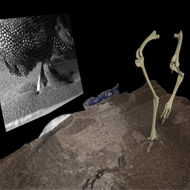
Information could be used to find out how bigger dinosaurs roamed the earth
Researchers from the Royal Veterinary College and Brown University are one step closer to unlocking the mysteries of fossilised footprints left by dinosaurs that walked the earth around 200 million years ago.
Dr Peter Falkingham, a research fellow in the RVC's Structure and Motion Lab, and co-author Professor Stephen Gatesy from Brown University, have, for the first time, been able to visualise the complex reorganisation of sedimentary particles during footprint formation.
The scientists imaged the subsurface foot movements of a chicken-like bird walking through soft sediment, and then used these movements to simulate the formation of a 3D, virtual footprint.
The simulation of the birds footprint was then compared to the fossilised track of a small dinosaur, similar in size to a small bird.
The work will help palaeontologists understand tracks left by dinosaurs on a deeper level.
Dr Falkingham said: “By observing how a footprint is formed, from the moment the foot hits the sediment until it leaves, we can directly associate motions with features left behind in the track. We can then study a fossil track left by a dinosaur and say ‘ok, these features of the track are similar, but these are different, so what does that mean for the way the animal was walking?’”
The virtual footprint was created by combining using a combination of 3D X-ray technology, animation and simulation.
The RVC say that going forward the research could be used to figure out how other, bigger dinosaurs roamed the earth, how prehistoric mammals migrated and even how early humans walked the land.
Image (C) Dr Peter L. Falkingham



 The RCVS has announced a new version of its 1CPD mobile app, with enhanced features for veterinary surgeons and veterinary nurses to record their continuing professional development.
The RCVS has announced a new version of its 1CPD mobile app, with enhanced features for veterinary surgeons and veterinary nurses to record their continuing professional development.